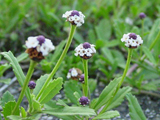Native Plants

Q. Who is Mr. Smarty Plants?
A: There are those who suspect Wildflower Center volunteers are the culpable and capable culprits. Yet, others think staff members play some, albeit small, role. You can torture us with your plant questions, but we will never reveal the Green Guru's secret identity.
Did you know you can access the Native Plant Information Network with your web-enabled smartphone?
Ask Mr. Smarty Plants is a free service provided by the staff and volunteers at the Lady Bird Johnson Wildflower Center.

rate this answer
Friday - June 08, 2012
From: Angier, NC
Region: Southeast
Topic: Soils, Problem Plants
Title: Zinc tolerant plants for sunny area
Answered by: Nan Hampton
QUESTION:
I have a very high zinc soil in an all day sun area. Any suggestions as to what kind of flower can I grow successfully? Zone 8 Thank youANSWER:
Zinc is one of the micronutrients needed for successful plant growth. However, concentrated levels of zinc can be detrimental to plant growth and, depending on the concentration of zinc, even result in the death of some plants. Zinc is a natural occurrence in air, soil and water, but concentrated levels can occur from human activities such as waste products of industry and mining. The information I can find about zinc tolerance in plants is related to phytoremediation of sites contaminated by heavy metals—including zinc. Plants successful in phytoremediation are able to accumulate the heavy metals in their tissues, thus removing them from the soil. The plants are then harvested and disposed of. In the course of these studies it has been determined that some plants are "accumulators" and take up high concentrations of heavy metals without a toxic effect. Other plants that grow in high concentrations of heavy metals turn out to be "excluders" and don't end up with high concentrations of heavy metals. They have the ability to exclude the heavy metals from uptake and continue growing on the site. For your purposes, however, you don't care which they do as long as they will grow on soils with high concentrations of zinc. As far as I can determine no one has produced a list or a study of beautiful flowering plants (native or non-native cultivars) that grow well on high zinc concentrations. Many of the studies have been carried out in Europe and Asia using plants native to those regions. Most of the North American native plants that have successfully grown on high zinc concentrations are not those that are considered particularly beautiful, but I do have some recommendations for you for plants that are native to North Carolina:
GRASSES
Festuca rubra (Red fescue). Here are photos.
Deschampsia cespitosa (Tufted hairgrass)
Sporobolus indicus (Smut grass)
HERBACEOUS PLANTS
Ambrosia artemisiifolia (Annual ragweed). Here are more photos and information.
Flaveria trinerva (threadleaf glowwort). Here are photos and more information.
Xanthium strumarium (Rough cockleburr). Here are more photos and information.
Solanum elaeagnifolium (Silverleaf nightshade)
Bidens alba (Common beggarticks). Here are more photos and information.
Desmodium paniculatum (Panicled tick trefoil). Here are more photos and information.
Phyla nodiflora (Texas frogfruit)
Solidago altissima (Tall goldenrod)
Tradescantia ohiensis (Bluejacket)
Sesbania herbacea (Bigpod sesbania)
The above plants were found in the following academic papers that could be available at a university near you:
Franco-Hernandez, M. O. et al. 2010. Heavy metals concentration in plants growing on mine tailings in Central Mexico. Bioresource Technology 101(11):3864-3869.
R. Carrillo González and M.C.A. González-Chávez. 2006. Metal accumulation in wild plants surrounding mining wastes. Environmental Pollution 144(1):84-92. (A study carried out in the state of Zacatecas in Mexico).
Joonki Yoon et al. 2006. Accumulation of Pb, Cu, and Zn in native plants growing on a contaminated Florida site. Science of the Total Environment 368(2-3):456-464.
You can also read the answer to a previous question about phytoremediation of lead in soil and the answer to a general question about phytoremediation.
Additionally, you might like to contact the Harnett County Office of the North Carolina State University Cooperative Extension Service. You are likely not the only person in the area having problems growing plants on soils with high concentrations of zinc and they might have other recommendations for you.
From the Image Gallery
More Problem Plants Questions
Eliminating silverleaf nightshade from Albuquerque NM
June 07, 2014 - I have silverleaf nightshade in my yard and would like to eradicate it (yeah, I know, good luck!) or at least control it. Do you have any suggestions?
view the full question and answer
How to eliminate roadside thistles
May 26, 2015 - When we drive along the highway we see lots of wildflowers and no thistles in the median. How does the Highway Department keep the thistles out? Here in Kerrville, we are overwhelmed by thistles thi...
view the full question and answer
A method for killing nandina and ligustrum with herbicide
October 19, 2012 - Is there an effective herbicide that can be painted on the stumps of Nandina and Wax-leaf ligustrum to keep them from growing back?
Thanks so much!
view the full question and answer
Should Mexican milkweed (Asclepias curassavica) not be used to attract Monarch butterflies?
November 20, 2015 - Should I remove Asclepias curassavica (Mexican milkweed) in my garden for threat of OE parasitic protozoan threat to Monarch butterflies? Is this threat as widespread as Chronicle implies? I had great...
view the full question and answer
Skin Reaction form Cochineal on Prickly Pear
February 16, 2015 - I have severe burning and peeling skin on pads of fingers after touching "white stuff" on a prickly pear. White stuff tuned purple then burned skin even after washing hands. Skin has been cracking a...
view the full question and answer
| Support the Wildflower Center by Donating Online or Becoming a Member today. |

